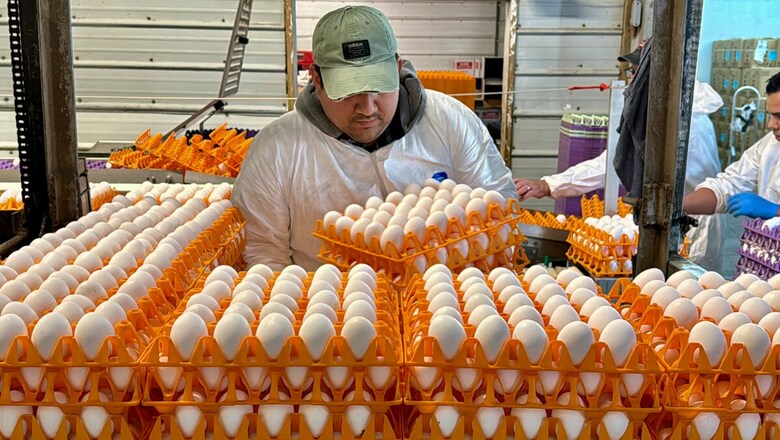
views
Last month, Mike Weber got the news every poultry farmer fears: His chickens tested positive for avian flu. Following government rules, Weber’s company, Sunrise Farms, had to slaughter its entire flock of egg-laying hens — 550,000 birds — to prevent the disease from infecting other farms in Sonoma County north of San Francisco.
“It’s a trauma. We’re all going through grief as a result of it,” said Weber, standing in an empty hen house. “Petaluma is known as the Egg Basket of the World. It’s devastating to see that egg basket go up in flames.” A year after the bird flu led to record egg prices and widespread shortages, the disease known as highly pathogenic avian influenza is wreaking havoc in California, which escaped the earlier wave of outbreaks that devastated poultry farms in the Midwest.
The highly contagious virus has ravaged Sonoma County, where officials have declared a state of emergency. During the past two months, nearly a dozen commercial farms have had to destroy more than 1 million birds to control the outbreak, dealing an economic blow to farmers, workers and their customers. Merced County in Central California also has been hit hard, with outbreaks at several large commercial egg-producing farms in recent weeks.
Experts say bird flu is spread by ducks, geese and other migratory birds. The waterfowl can carry the virus without getting sick and easily spread it through their droppings to chicken and turkey farms and backyard flocks through droppings and nasal discharges. California poultry farms are implementing strict biosecurity measures to curb the spread of the disease. State Veterinarian Annette Jones urged farmers to keep their flocks indoors until June, including organic chickens that are required to have outdoor access.
“We still have migration going for another couple of months. So we’ve got to be as vigilant as possible to protect our birds,” said Bill Mattos, president of the California Poultry Federation. The loss of local hens led to a spike in egg prices in the San Francisco Bay Area over the holidays before supermarkets and restaurants found suppliers from outside the region.
While bird flu has been around for decades, the current outbreak of the virus that began in early 2022 has prompted officials to slaughter nearly 82 million birds, mostly egg-laying chickens, in 47 U.S. states, according to the U.S. Department of Agriculture. Whenever the disease is found the entire flock is slaughtered to help limit the spread of the virus.
The price of a dozen eggs more than doubled to $4.82 at its peak in January 2023. Egg prices returned to their normal range as egg producers built up their flocks and outbreaks were controlled. Turkey and chicken prices also spiked, partly due to the virus. “I think this is an existential issue for the commercial poultry industry. The virus is on every continent, except for Australia at this point,” said Maurice Pitesky, a poultry expert at the University of California, Davis.
Climate change is increasing the risk of outbreaks as changing weather patterns disrupt the migratory patterns of wild birds, Pitesky said. For example, exceptional rainfall last year created new waterfowl habitat throughout California, including areas close to poultry farms. In California, the outbreak has impacted more than 7 million chickens in about 40 commercial flocks and 24 backyard flocks, with most of the outbreaks occurring over the past two months on the North Coast and Central Valley, according to the USDA.
Industry officials are worried about the growing number of backyard chickens that could become infected and spread avian flu to commercial farms. “We have wild birds that are are full of virus. And if you expose your birds to these wild birds, they might get infected and ill,” said Rodrigo Gallardo, a UC Davis researcher who studies avian influenza.
Gallardo advises the owners of backyard chickens to wear clean clothes and shoes to protect their flocks from getting infected. If an unusual number of chickens die, they should be tested for avian flu. Ettamarie Peterson, a retired teacher in Petaluma, has a flock of about 50 chickens that produce eggs she sells from her backyard barn for 50 cents each.
“I’m very concerned because this avian flu is transmitted by wild birds, and there’s no way I can stop the wild birds from coming through and leaving the disease behind,” Peterson said. “If your flock has any cases of it, you have to destroy the whole flock.” Sunrise Farms, which was started by Weber’s great-grandparents more than a century ago, was infected despite putting in place strict biosecurity measures to protect the flock.
“The virus got to the birds so bad and so quickly you walked in and the birds were just dead,” Weber said. “Heartbreaking doesn’t describe how you feel when you walk in and perfectly healthy young birds have been just laid out.” After euthanizing more than half a million chickens at Sunrise Farms, Weber and his employees spent the Christmas holiday discarding the carcasses. Since then, they’ve been cleaning out and disinfecting the hen houses.
Weber hopes the farm will get approval from federal regulators to bring chicks back to the farm this spring. Then it would take another five months before the hens are mature enough to lay eggs. He feels lucky that two farms his company co-owns have not been infected and are still producing eggs for his customers. But recovering from the outbreak won’t be easy. “We have a long road ahead,” Weber said. “We’re going to make another run of it and try to keep this family of employees together because they’ve worked so hard to build this into the company that it is.”


















Comments
0 comment